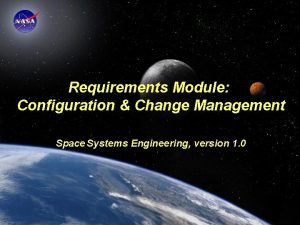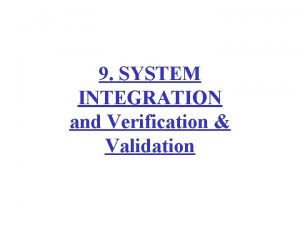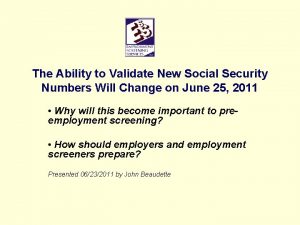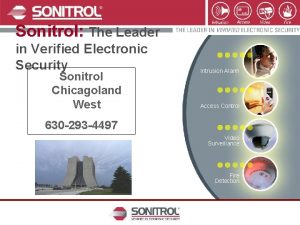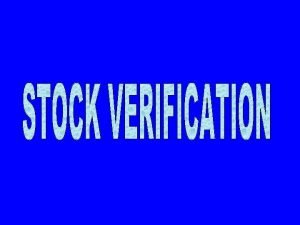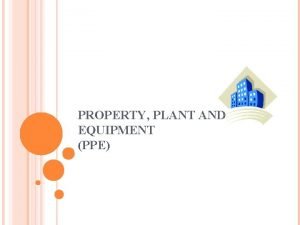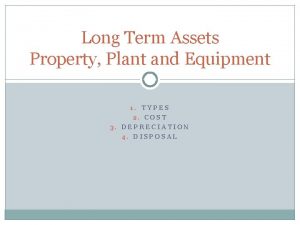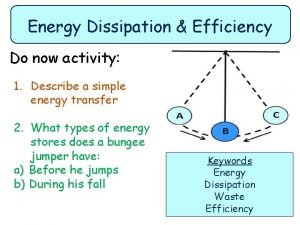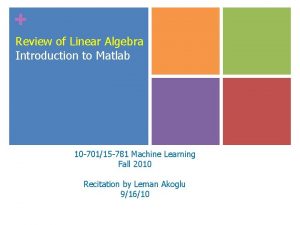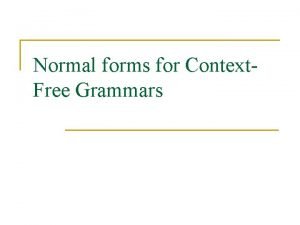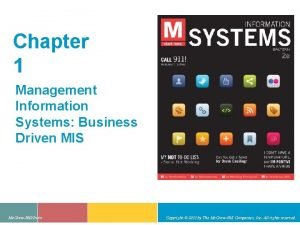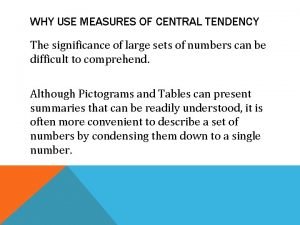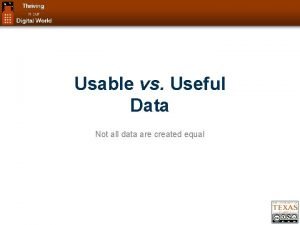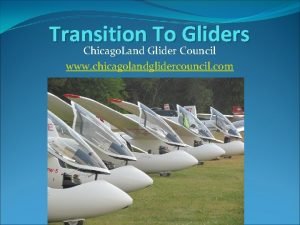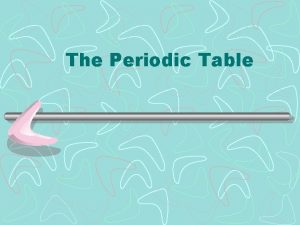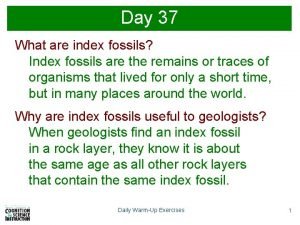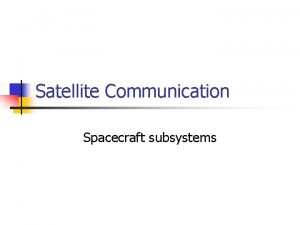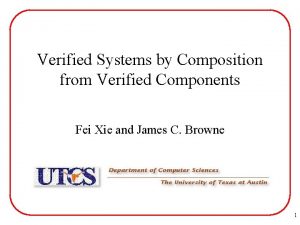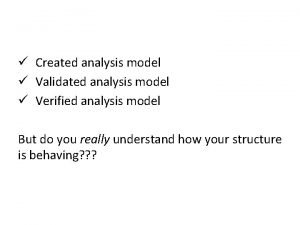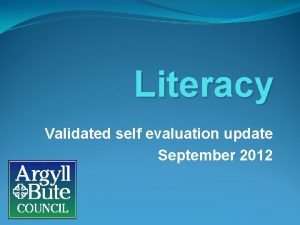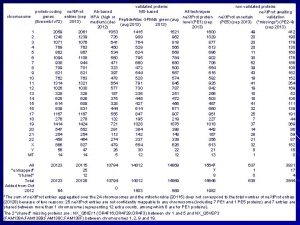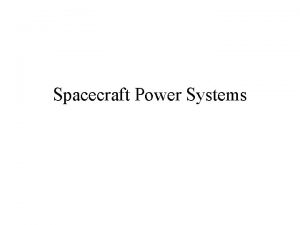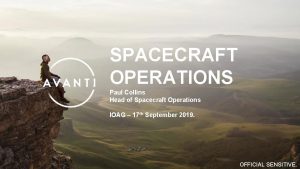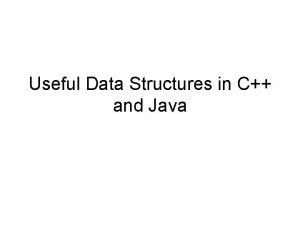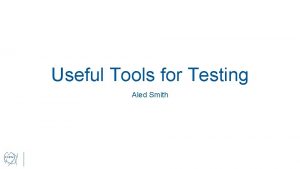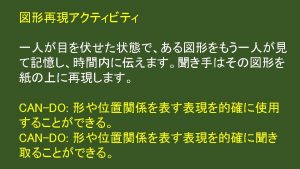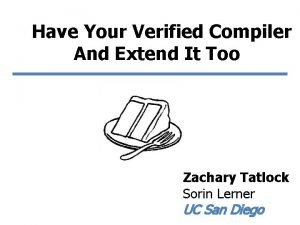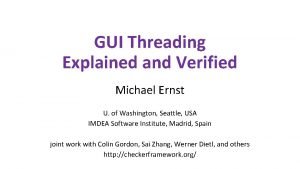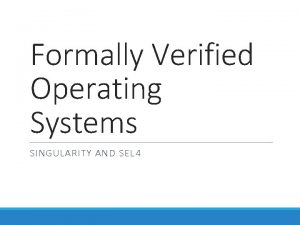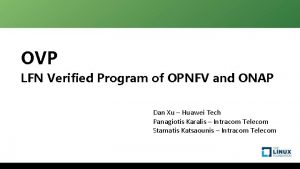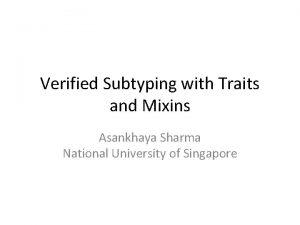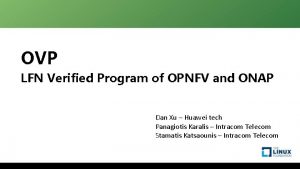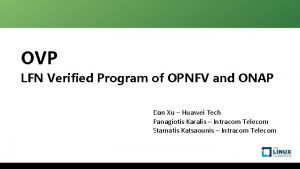Nascap2 k A Useful Validated and Verified Spacecraft






























- Slides: 30

Nascap-2 k, A Useful, Validated and Verified Spacecraft Surface Charging Code Dale C. Ferguson Lead for Spacecraft Charging Science and Technology Space Vehicles Directorate Air Force Research Laboratory Active Experiments in Space: Past, Present, and Future Sept. 12, 2017 DISTRIBUTION A: Approved for public release; distribution unlimited (CASE NUMBER GOES HERE) Distribution A: Approved for public release; distribution unlimited

What Is Nascap-2 k? • • • 2 • • Nascap-2 k is a full 3 -D fully GUI computer code to calculate the interactions of a spacecraft with its LEO, GEO, Polar, or interplanetary plasma environment Interactions include: – Surface potentials • Charged particle spectra (electrons and ions) • Secondary electron emission • Bulk and surface conductivity – Current collection • Applied frame and distributed potentials – Perturbation of near-field environment • Space Potentials • Thruster plumes • Charge exchange ion flow Calculations are analytic where possible, PIC (particle-in-cell) where desired Code features – Object and grid definition – Simplified user interface for problem definition and execution – Graphical display of results Developed by Leidos, Inc. under AFRL and NASA sponsorship Resides on your own computer, no web-login necessary SCTC 2010 N 2 k DISTRIBUTION A: Approved for public release; distribution unlimited (CASE NUMBER GOES HERE) Distribution A: Approved for public release; distribution unlimited 2

Nascap-2 k Core Capabilities • • • 3 SCTC 2010 N 2 k Defines spacecraft surface geometry Grids space surrounding spacecraft Calculates environmentally induced time-dependent surface potentials Calculates external potentials: – Analytic space charge (5 models) – Macroparticle space charge (4 models) Generates and tracks macroparticles – Uniform with boundary injection – Sheath generation – Charge exchange Post-processing: – Time-dependent surface potentials and currents – Time-dependent volume potentials, currents, and densities Distribution A: Approved for public release; distribution unlimited DISTRIBUTION A: Approved for public release; distribution unlimited (CASE NUMBER GOES HERE) 3

Object Toolkit • • • Builds spacecraft surface models Uses intrinsic building blocks Imports from finite-element preprocessors Surface attributes from database or user-definable – Material name • Conductivity • Secondary electron emission • Thickness, etc. – Conductor number Customizable to other applications via an external file 4 SCTC 2010 N 2 k Distribution A: Approved for public release; distribution unlimited DISTRIBUTION A: Approved for public release; distribution unlimited (CASE NUMBER GOES HERE) 4

Object Toolkit Examples 5 SCTC 2010 N 2 k Distribution A: Approved for public release; distribution unlimited DISTRIBUTION A: Approved for public release; distribution unlimited (CASE NUMBER GOES HERE) 5

Nascap-2 k GUI Input tabs Proble m Environme nt Charge Density Formulation Particle and Initialization Tracking 6 SCTC 2010 N 2 k Distribution A: Approved for public release; distribution unlimited DISTRIBUTION A: Approved for public release; distribution unlimited (CASE NUMBER GOES HERE) 6

VALIDATION DISTRIBUTION A: Approved for public release; distribution unlimited (CASE NUMBER GOES HERE) Distribution A: Approved for public release; distribution unlimited 7

GEO Validation vs NASCAP/GEO and SEE Handbook DISTRIBUTION A: Approved for public release; distribution unlimited (CASE NUMBER GOES HERE) Distribution A: Approved for public release; distribution unlimited 8

GEO Validation vs MUSCAT and Coulomb-2 DISTRIBUTION A: Approved for public release; distribution unlimited (CASE NUMBER GOES HERE) Distribution A: Approved for public release; distribution unlimited 9

LEO Validation vs Langmuir Blodgett, Parker. Murphy • Upper left – I vs Number Density • 10 cm radius 100 V sphere • Te = 0. 2 e. V • Upper Right – I vs V • 1011 m-3 • Te = 0. 2 e. V • Lower Left – I vs B DISTRIBUTION A: Approved for public release; distribution unlimited (CASE NUMBER GOES HERE) Distribution A: Approved for public release; distribution unlimited 10

VERIFICATION DISTRIBUTION A: Approved for public release; distribution unlimited (CASE NUMBER GOES HERE) Distribution A: Approved for public release; distribution unlimited 11

Derivation of F (E > Emin) as Charging Index (1) DISTRIBUTION A: Approved for public release; distribution unlimited (CASE NUMBER GOES HERE) Distribution A: Approved for public release; distribution unlimited 12

Secondary Electron Emission Nominal secondary electron yield curve for a “typical” material DISTRIBUTION A: Approved for public release; distribution unlimited (CASE NUMBER GOES HERE) Distribution A: Approved for public release; distribution unlimited 13

Flux above Emin Maxwellians f(E) 0. 4 0. 35 f(E) 0. 3 0. 25 2000 0. 2 4000 0. 15 8000 0. 1 16000 0. 05 32000 0 0 5000 10000 15000 E (e. V) 20000 25000 30000 Normalized differential fluxes for Maxwellians of the same electron density but different temperatures. A hypothetical Emin is shown by the dashed line DISTRIBUTION A: Approved for public release; distribution unlimited (CASE NUMBER GOES HERE) Distribution A: Approved for public release; distribution unlimited 14

Derivation of F (E > Emin) as Charging Index (2) • As the plasma temperature (θ) increases, the fraction of incident electrons above the second crossover point increases, until at some temperature, the net electron flux must be zero. • In sunlight, because of the added emitted electrons from the photoelectric effect, this temperature must be even greater, so Emin must be taken to be an energy well above the second crossover. • It is this heightened temperature that Shu Lai called the critical temperature, below which no negative absolute charging can occur. • Photoemission and secondary electron emission are materials properties, so Emin is different for different materials. • As spacecraft vary in the relative areas of surface materials, Emin will vary between different spacecraft. DISTRIBUTION A: Approved for public release; distribution unlimited (CASE NUMBER GOES HERE) Distribution A: Approved for public release; distribution unlimited 15

Published data from satellites that measured charging - SCATHA Differential electron fluxes on SCATHA for Sept. 22, 1982 (dashed line) compared with the average of two different one-week periods (“error bars”), from Roeder. Error bars show the extremes for the “nominal” two 7 day periods, and thus can be considered well over 1 sigma away from the mean DISTRIBUTION A: Approved for public release; distribution unlimited (CASE NUMBER GOES HERE) Distribution A: Approved for public release; distribution unlimited 16

Nascap-2 k Determination of Emin for the typical spacecraft model of Ferguson and Wimberly (FW) Single Maxwellians, r 2 for F (E>Emin) vs Emin Double Maxwellians, r 2 for F (E>Emin) vs Emin 1. 05 1 0. 95 Max-Abs 1 Poly. (Max-Abs) 0. 95 Poly. (Max-Min) Poly. (-Abs Chg) 0. 9 r 2 -Abs Chg Max-Abs 0. 9 Max-Min 0. 85 -Abs Chg Poly. (Max-Abs) 0. 8 Poly. (Max-Min) 0. 75 Poly. (-Abs Chg) 0. 7 0 10 20 Emin (ke. V) 30 40 Squared correlations of daytime charging values with absolute (frame) and differential charging for the single Maxwellian charging cases and spacecraft model of FW. Note the essentially perfect correlation of (-Abs Chg) at Emin=11 ke. V 0 10 20 Emin (ke. V) 30 40 Squared correlations of daytime charging values with absolute (frame) and differential charging for the double Maxwellian charging cases and spacecraft model of FW DISTRIBUTION A: Approved for public release; distribution unlimited (CASE NUMBER GOES HERE) Distribution A: Approved for public release; distribution unlimited 17

Published data from satellites that measured charging – DSCS-III B 7 DSCS-III Figure 13 of Kraus et al 2004, showing the differential voltage of the surface potential monitors (SPMs) for Kapton and Astroquartz with respect to the chassis potential. DISTRIBUTION A: Approved for public release; distribution unlimited (CASE NUMBER GOES HERE) Distribution A: Approved for public release; distribution unlimited 18

The influence of spacecraft configurations 3 -Axis Stabilized, dscsmini model Simple Nascap-2 k model of the DSCS-III satellite, named “dscsmini” DISTRIBUTION A: Approved for public release; distribution unlimited (CASE NUMBER GOES HERE) Distribution A: Approved for public release; distribution unlimited 19

The influence of spacecraft configurations 3 -Axis Stabilized, dscsmini model Dscsmini Chging vs F# 20 -50 ke. V, Single Maxwellians 2. 00 E+04 R 2 = 9. 31 E-01 (Abs-Min), volts 1. 50 E+04 1. 00 E+04 R 2 = 9. 29 E-01 dscsmini -Abs dscsmini (Abs-Min) 5. 00 E+03 dscsmini (Max-Min) 0. 00 E+00 R 2 = 9. 31 E-01 -5. 00 E+03 0. 00 E+00 2. 00 E+08 4. 00 E+08 6. 00 E+08 8. 00 E+08 1. 00 E+09 1. 20 E+09 1. 40 E+09 Electrons cm-2 sec-1 from 20 -50 ke. V Charging vs. electron number fluxes for 20 ke. V < E < 50 ke. V from dscsmini model for comparison with DSCS-III data DISTRIBUTION A: Approved for public release; distribution unlimited (CASE NUMBER GOES HERE) Distribution A: Approved for public release; distribution unlimited 20

Published data from satellites that measured charging – DSCS-II B 7 (Abs-Min) Chging vs F# 20 -50 ke. V 4500 4000 (Abs-Min), volts 3500 3000 2500 Mean Krause Astroquartz 2000 Mean Krause Kapton 1500 Linear(dscsmini) 1000 500 0 0 E+00 5 E+08 1 E+09 Electrons cm-2 sec-1 from 20 -50 ke. V 2 E+09 The Krause et al DSCS data normalized to 2 million electrons per second per cm 2 per count compared to the dscsmini Nascap-2 k model predictions (dashed line) DISTRIBUTION A: Approved for public release; distribution unlimited (CASE NUMBER GOES HERE) Distribution A: Approved for public release; distribution unlimited 21

The influence of spacecraft configurations - Spinners False color Nascap-2 k surface-materials model of SCATHA DISTRIBUTION A: Approved for public release; distribution unlimited (CASE NUMBER GOES HERE) Distribution A: Approved for public release; distribution unlimited 22

The influence of spacecraft configurations - Spinners Potentials after 2010 seconds, ATS-6 environment, rotating at 1 rpm. Inset at lower left shows the bottomside of the Teflon cylindrical antenna cover, from which ions are partially blocked DISTRIBUTION A: Approved for public release; distribution unlimited (CASE NUMBER GOES HERE) Distribution A: Approved for public release; distribution unlimited 23

Published data from satellites that measured charging - SCATHA Sept. 22, 1982 -Vgold (volts) vs Fetot (A/m 2) 800 700 600 R 2 = 8. 41 E-01 500 400 300 200 100 0 -100 -200 0 E+00 1 E-06 2 E-06 3 E-06 4 E-06 5 E-06 6 E-06 • Plot of SCATHA gold potential versus total electron flux • The apparent threshold at about 1 micro. Amp/m 2 agrees with FW • Noise may be partially due to the spacecraft rotation, which may be as much as a factor of two • Since we have assumed the same plasma temperature for all of these data points, agreement with Nascap-2 k predictions for total flux also applies to fluxes above any Emin DISTRIBUTION A: Approved for public release; distribution unlimited (CASE NUMBER GOES HERE) Distribution A: Approved for public release; distribution unlimited 24

The influence of spacecraft configurations - Spinners SCATHA model in Sunlight, Rotating, Axis ┴ Sun 14000 SCATHA Model, Rotating, Axis to Earth, LT = 2 hrs 14000 12000 10000 8000 -Abs 6000 Max-Min 4000 Abs-Min Volts 8000 6000 -Abs Max-Min 4000 Abs-Min 2000 0 0 R 2 = 9. 87 E-01 -2000 0. 0 E+00 5. 0 E+08 1. 0 E+09 1. 5 E+09 2. 0 E+09 2. 5 E+09 #F (E > 9 ke. V), cm-2 sec-1 Potentials of the detailed rotating SCATHA model after 2010 seconds of charging. Note threshold in frame charging at about 3. 9 x 108 e-/cm 2 sec -2000 0. 0 E+00 5. 0 E+08 1. 0 E+09 1. 5 E+09 2. 0 E+09 #F (E > 9 ke. V), cm-2 sec-1 2. 5 E+09 Potentials for SCATHA model, rotating around axis pointed at Earth, for 2010 seconds. Note thresholds at about 3. 9 x 108 e-/cm 2 sec DISTRIBUTION A: Approved for public release; distribution unlimited (CASE NUMBER GOES HERE) Distribution A: Approved for public release; distribution unlimited 25

Published data from satellites that measured charging – INTELSATs The charging event on INTELSATs 806 (light lines) and 803 (dark lines) z-sensors on August 4, 2010. The colored lines indicate local midnight, so the spacecraft charged in the morning sector. Abs-CPA 0 -20 Volts -40 -60 -80 -100 -120 -140 0 500 1000 1500 Seconds 2000 2500 Nascap-2 k calculated differential potentials for the CPA position on the geobird satellite model. Distribution A: Approved for public release; distribution unlimited DISTRIBUTION A: Approved for public release; distribution unlimited (CASE NUMBER GOES HERE) 26

Desirability of On-Board Sensors Chging of Materials vs Chging of Gold R 2 = 9. 61 E-01 10000 Volts R 2 = 9. 60 E-01 OSR 1000 Kapton Teflon Astroquartz R 2 = 6. 59 E-01 R 2 = 8. 88 E-02 100 Potential of the SCATHA Gold Surface Potential Monitor on Sept. 22, 1982 with respect to the spacecraft along with Pulse Analyzer arc detections. 500 550 600 Gold, Volts 650 700 Potential of other SPM sensors relative to gold (from Koons et al 1988). DISTRIBUTION A: Approved for public release; distribution unlimited (CASE NUMBER GOES HERE) Distribution A: Approved for public release; distribution unlimited 27

The influence of spacecraft configurations - Spinners • In terms of a Nascap-2 k non-rotating SCATHA model in daylight (results not shown), we can make these generalizations: 1. Frame charging (-Abs) in the rotating case is only about ¼ that in the non-rotating case. This is because with rotation, many more surfaces see the sun and can be intermittently discharged by photoemission. 2. The differential charging (Max-Min) in the rotating case is ¼ to ½ of what it would be in the absence of rotation. 3. The differential charging (Abs-Min) in the rotating case is 1/3 to ½ of what it would be in the absence of rotation. DISTRIBUTION A: Approved for public release; distribution unlimited (CASE NUMBER GOES HERE) Distribution A: Approved for public release; distribution unlimited 28

Summary Nascap-2 k has been well validated and verified Object Toolkit is ideal for modeling spacecraft to the right level of detail Nascap-2 k is freely available to all US citizens and companies Nascap-2 k is useful in design, testing, and operations It has tools that enable modeling in the presence of: • changing plasma conditions • spacecraft rotation • high voltage solar arrays • thruster plumes • Orbital environments it treats: • LEO equatorial • LEO polar • MEO • GEO • Interplanetary • Depending on the level of accuracy desired, Nascap-2 k is the fastest and most accurate spacecraft charging program in the world, and secure because it runs on your own computer • • • DISTRIBUTION A: Approved for public release; distribution unlimited (CASE NUMBER GOES HERE) Distribution A: Approved for public release; distribution unlimited 29

Questions? DISTRIBUTION A: Approved for public release; distribution unlimited (CASE NUMBER GOES HERE) Distribution A: Approved for public release; distribution unlimited 30
 Spacecraft requirements management
Spacecraft requirements management Validated system integration
Validated system integration Cpn ssn validator
Cpn ssn validator Verified credentials uthsc
Verified credentials uthsc Sonitrol las vegas
Sonitrol las vegas Verification of stock in trade
Verification of stock in trade The useful
The useful Ppe structure
Ppe structure Useful and harmful microbes
Useful and harmful microbes Net book value
Net book value Useful life of property plant and equipment
Useful life of property plant and equipment Useful and wasted energy worksheet
Useful and wasted energy worksheet Linearly independent vectors
Linearly independent vectors Unit production grammar
Unit production grammar Useful and wasted energy grade 7
Useful and wasted energy grade 7 What is data converted into a meaningful and useful context
What is data converted into a meaningful and useful context Writing an informal email to a friend
Writing an informal email to a friend Why is the median useful
Why is the median useful What characteristics make hair a useful forensics tool?
What characteristics make hair a useful forensics tool? Useful microbes adalah
Useful microbes adalah Usable useful
Usable useful Time of useful consciousness
Time of useful consciousness How is the periodic table useful
How is the periodic table useful Useful records
Useful records How useful is this source
How useful is this source How useful is this source
How useful is this source When climbing where do you need high friction
When climbing where do you need high friction Thank you and have a great day email
Thank you and have a great day email Why are index fossils useful to geologists? *
Why are index fossils useful to geologists? * Interstitial ceilings
Interstitial ceilings Why is mass more useful than weight for measuring matter
Why is mass more useful than weight for measuring matter
